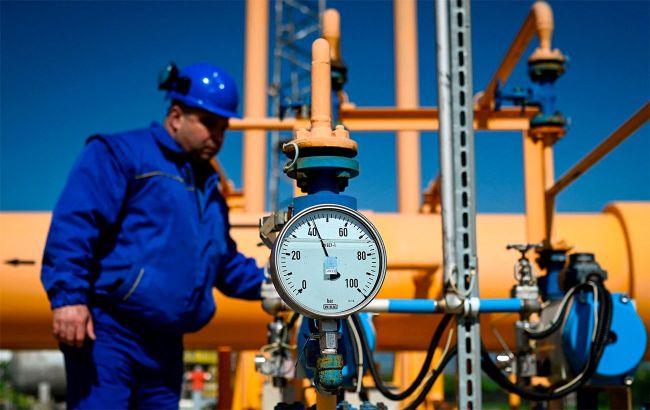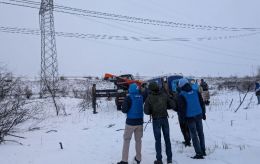Why Russian gas is back on top in Europe and how EU plans to hit LNG imports
 Photo: EU imposes sanctions on Russian LNG as gas supplies to Europe rise (Getty Images)
Photo: EU imposes sanctions on Russian LNG as gas supplies to Europe rise (Getty Images)
Despite European countries' attempts to reduce their dependence on Russian gas, an unexpected situation occurred last month. In May, Russia again became the top supplier, surpassing the United States for the first time in nearly two years.
RBC-Ukraine explains why and how the European Union plans to hit Russia's revenues from liquefied natural gas (LNG) supplies.
Content
- Russia surpasses the US: How it happened and how long it will last
- Ukraine wants to preserve route: What gas will flow through GTS
- How EU plans to hit Russian LNG
Russia surpasses the US: How it happened and how long it will last
After Russia's full-scale invasion of Ukraine in February 2022, Moscow reduced its pipeline gas supplies to Europe, which simultaneously increased its LNG imports.
By September 2022, the United States had become the leading supplier, surpassing Russia. Since 2023, the US has accounted for about 20% of Europe's gas imports. However, in May, for the first time in nearly two years, Russian volumes exceeded American ones.
According to the global commodity pricing and analysis platform ICIS, last month, pipeline and LNG from Russia accounted for 15% of the total gas supply to the European Union, the United Kingdom, Switzerland, Serbia, Bosnia and Herzegovina, and North Macedonia.
Meanwhile, LNG from the US accounted for 14%, the lowest level since August 2022.
One-off factors, including the shutdown of a major US LNG export facility, influenced the May flows. Russia increased pipeline exports through Türkiye ahead of scheduled maintenance in June.
ICIS gas analyst Tom Marzec-Manser believes this trend will not last long, as US LNG production will grow again. Russia will likely reduce volumes for Europe, redirecting them to Asian countries.
"Russia has limited flexibility to hold on to this share [in Europe] as demand [for gas] rises into next winter, whereas overall US LNG production is only growing with yet more new capacity coming to the global market by the end of the year," he told the Financial Times.
According to the Center for Research on Energy and Clean Air (CREA), in May, the European Union became Russia's fourth-largest importer of fossil fuels.
It is worth noting that sanctions do not apply to gas, which, besides pipelines through Türkiye and Ukraine, is supplied by tankers (in the case of LNG). Last month, Hungary imported gas worth 122 million euros, Slovakia - 117 million euros, the Czech Republic - 81 million euros, France - 196 million euros, and Belgium - 178 million euros. The latter two countries import liquefied gas, and supplies from Russia to France increased by 14% in May and to Belgium by 15%.
Interestingly, although many EU countries are pushing for sanctions against Russian LNG, gas supplies have been slowly increasing since the fourth quarter of 2022. This underscores the complexity of reducing Europe's dependence on Russian gas.
On the other hand, the transit contract through Ukraine expires at the end of the year. Ukrainian authorities will not conduct direct negotiations with Russia. However, according to Western media, Europe is currently discussing how to load the Ukrainian gas transportation system starting in 2025.
Ukraine wants to preserve route: What gas will flow through GTS
Russia pumps about 15 billion cubic meters of gas annually through Ukraine, primarily to Slovakia and Austria, where it remains the dominant supplier. For example, Russian gas covers over 80% of Austria's consumption in the last five months.
Since these volumes are difficult to replace in the short term, the EU is interested in maintaining the Ukrainian route. However, this does not mean that Russian gas will continue to be supplied in 2025.
According to Bloomberg, negotiations are underway with Ukraine to ensure supplies next year. One option is to purchase gas from Azerbaijan, which would be transported through Russian pipelines and the Ukrainian gas transportation system (GTS).
The idea is gaining traction because it is becoming clear that otherwise, Ukraine could lose an important source of revenue. In 2021, Ukraine was estimated to earn about $1 billion from transit. Therefore, the Ukrainian side suggests that supplies from Azerbaijan may have some future.
Bloomberg writes that Azerbaijani company Socar did not respond to requests for comment, nor did Russian Gazprom, whose capacities are also involved in the potential scheme. Theoretically, the deal could also benefit Russia if organized on a swap basis—that is, Azerbaijani gas on paper but actually Russian gas.
Swaps are not unfamiliar to gas markets and are used when delivering fuel from one place to another is physically impossible. Moreover, Azerbaijan already uses its pipeline system to Europe at total capacity, and further export increases would require expensive infrastructure upgrades.
Negotiations are still in the early stages, and a decision may be made by the end of the year. However, the agency notes that it is unclear whether a deal will result, as it could be influenced by events in the Russian-Ukrainian war.
Another option could be a consortium of European companies or countries or an appointed third party to take over gas supplies from Gazprom at the Russian-Ukrainian border. Publicly, the European Commission claims that the bloc can withstand the cessation of Russian transit through Ukraine without risks to its energy security.
Armida van Rij, a Senior Research Fellow and Head of the Europe program at the Royal Institute of International Affairs Chatham House believes that if the EU's dependence on Russian gas has shown anything, it is the danger of over-reliance on a single supplier.
Therefore, finding other suppliers is the only option for a pragmatic and sustainable energy security policy. As Brussels is imposing sanctions on LNG from Russia, van Renssen notes, action is needed now.
"If and when the EU moves to ban Russian LNG imports, it must also look carefully at the countries of origin of the replacement pipeline gas or LNG. Importing laundered Russian gas will not help the EU achieve its foreign policy objectives. In fact, it could undermine them.," she added.
How EU plans to hit Russian LNG
"Historic" sanctions against Russian gas were agreed upon last week. The 14th package is expected to ban Russian companies from using EU ports to transship LNG from large tankers to smaller vessels for third countries. While this doesn't amount to a full embargo, it still represents a significant blow to Russia.
The crux of the matter is that Russia transports liquefied gas from its largest plant, Yamal LNG, in the far north to European ports, relying on Arctic icebreakers. According to research by non-governmental organizations, this transshipment has brought Russia about €3.4 billion in revenue.
The sanctions include measures against the "shadow fleet" of oil tankers and financial institutions that help Moscow circumvent sanctions banning the export of technologies critical for weapon production.
The decision on June 20 marks a noticeable evolution in European strategy. As stated by the Belgian presidency of the EU, these will be unprecedented sanctions against Russia's lucrative gas sector. This is a significant moment, but the sanctions won't affect most of the LNG exports to Europe, Politico writes.
The restrictions on LNG fall short of a total ban on coal and seaborne oil imports. EU companies are still allowed to purchase liquefied gas, with only the re-export of Russian LNG to other countries being banned.
Since Russia's full-scale invasion of Ukraine, the bloc has reduced its dependence on Russian gas by about two-thirds. Imports and resale of LNG continue.
According to CREA, in 2023, EU countries redirected about 22% of Russian LNG worldwide. The figures reflect the West's leading role in insuring cargo and transport services. Last year, the maritime sector of G7 countries provided 93% of Russia's LNG exports, with transportation costs amounting to €15.5 billion, Euronews notes.
The new EU sanctions aim to limit Russia's lucrative business and its ability to generate revenue for financing the war against Ukraine.
"Although the trans-shipment ban makes Russia's gas exports more difficult, only a complete ban on imports would really put the Russian gas business from the Arctic under pressure. Without the nearby EU ports, gas transportation on special icebreaker LNG tankers would hardly be economically viable," said Petras Katinas, an energy analyst at CREA.
Last year, Russian LNG exports to Europe cost Moscow over €8 billion in profit. Since the 14th package doesn't ban direct deliveries, Politico writes that the sanctions are likely to affect only about €2 billion.
In any case, it will take several months to assess how significantly Russian gas supplies will decrease due to the sanctions. For now, EU countries still need to approve them. The restrictions are expected to come into effect at the beginning of the week following their material in the Official Journal of the EU.
Sources: the Center for Research on Energy and Clean Air (CREA), materials by Chatham House, FT, Bloomberg, Politico, and Euronews.

